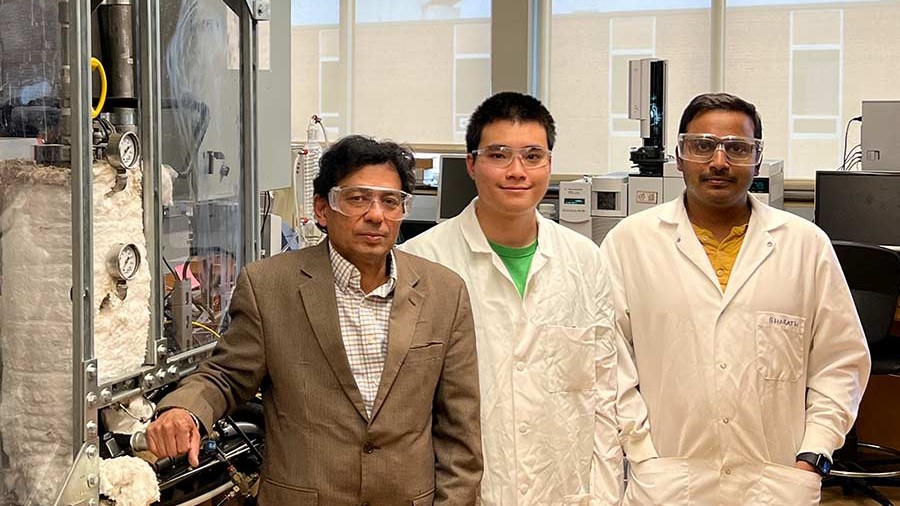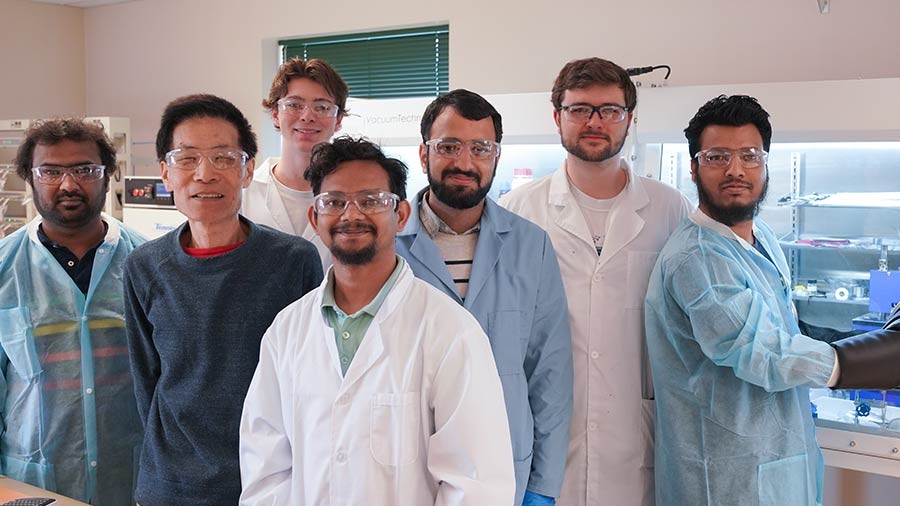Corn Stalks in Space: NASA Next-Gen Battery Breakthrough at South Dakota Mines

This piece by South Dakota Mines was published April 4.
Photo: Dr. Rajesh Shende and Ph.D. students, Khang Huynh and Bharath Maddipudi, in Shende’s laboratory at South Dakota Mines.
South Dakota Mines has received a new $750,000 NASA EPSCoR grant to fund research into the next generation of lithium-sulfur batteries for use in space technology. The grant comes following a breakthrough on campus into a new polymer-biocarbon cathode coating made from corn stalk residues that stabilizes next-generation battery chemistry to nearly double the charging capacity of current technology.
A press release from NASA on this research states, “Improving the power capacity and life of batteries could help NASA power rockets, spacecraft, and habitats on the Moon, and eventually, Mars.”
The breakthrough began with the work of Rajesh Shende, Ph.D., on finding new uses for biorefinery waste leftover from the bioprocessing plants, such as those that turn corn into ethanol. Shende and his team of researchers found that agriculture residue such as corn stalks, or stover, could be turned into a battery-grade biocarbon. Ph.D. students Khang Huynh and Bharath Maddipudi worked with Shende to develop a polymer-coated porous carbon for energy storage applications. Then, in 2020, Weibing Xing, Ph.D., joined the mechanical engineering department at Mines. Xing’s expertise is in next-generation lithium batteries.
“Lithium-ion has been around for like 30 years, and lithium-sulfur batteries are widely regarded as the most promising next-generation batteries with the highest energy density,” says Xing.
But Xing notes there are inherent problems with the chemistry of lithium-sulfur batteries that reduce their ability to store the full amount of energy they should be able to hold. At Mines, Xing began working with the Center for Solid-State Electric Power Storage and the Governor’s Research Center for Electrochemical Energy Storage on the problems with lithium-sulfur batteries. Shende reached out to mention the possibility that the battery-grade biocarbon his team developed from corn stover might be useful in Xing’s research.
“We thought, what the heck, let’s try it,” says Xing. “We coated a nano-layer of the biocarbon on the cathode of a lithium-sulfur battery. This had never before been done in the world,” says Xing.
To the surprise and delight of the research team, it worked.
“All the sudden instead of somewhat low energy storage, the battery went to nearly its full theoretical storage capacity,” says Xing. “It was a completely unexpected discovery,” he says.
The new polymer-biocarbon cathode coating worked so well in these batteries that the team wanted to triple-check their work. “We could not believe it,” says Xing. “We were asking, ‘Is this real? Is this actually true?’” So, the team retested the material and analyzed the results with several methods. In the end, the results held up.
“If you go looking for these breakthroughs they never seem to happen, you sort of have to stumble on one,” Xing says with a smile. “This was purely luck; we kind of discovered it, to our surprise.”
The unique nano-thin layer of polymer coated biocarbon on the cathode side of the lithium-sulfur battery helps stabilize the chemistry inside batteries and increases their storage capacity. This breakthrough is thanks to the multidisciplinary collaboration and culture at Mines.
“This is the beauty of collaboration,” says Xing. “This is something that would not happen at a bigger university where research is more walled off,” says Ed Duke, Ph.D., a professor of geology and geological engineering at Mines and director of the South Dakota Space Grant Consortium. “This is how discovery is so often made,” Xing adds.
The grant, thanks to NASA EPSCoR, allows researchers to continue to study this material and optimize its potential in next generation batteries. The grant also brings in NASA researchers who will work alongside those at Mines and other universities like University of South Dakota and South Dakota State University.
“There is something of a critical mass on energy research going on at this campus and in the state,” says Duke. “We’ve been collaborating with those at the University of South Dakota, and, thanks to this grant, we are being joined by those at NASA to continue this research.”
Xing says future research will work on other challenges with these batteries including reducing their flammability and continuing to optimize capacity. He has several graduate and undergraduate students already working in his state-of-the-art lab on campus.
“We are very excited to work on this very advanced lithium-sulfur battery technology,” he says.
Xing adds there is immense commercialization potential in this technology. Shende’s graduate students, Huynh and Maddipudi, are already working on one avenue of commercialization and job creation from one version of this product. The broad range of applications could include everything from large-scale energy storage for power plants to national defense, along with multiple uses in everyday life from cell phones to electric cars. Thanks to NASA, those future applications also include space travel.
“It’s nice to think that someday material derived from South Dakota corn stalks might be part of the batteries on NASA space missions,” says Duke.
Photo: Dr. Weibing Xing, (second from left) and his research team (from left to right: Gulam Smdani, Weibing Xing, Haiden Studer, Wahid Hasan, Amir Razzaq, Chris Poches and Salman Khan Mithil) in a next-generation battery research laboratory at South Dakota Mines.

 National Science Foundation RII Track-1 Project:Expanding Research, Education and Innovation in South Dakota
National Science Foundation RII Track-1 Project:Expanding Research, Education and Innovation in South Dakota